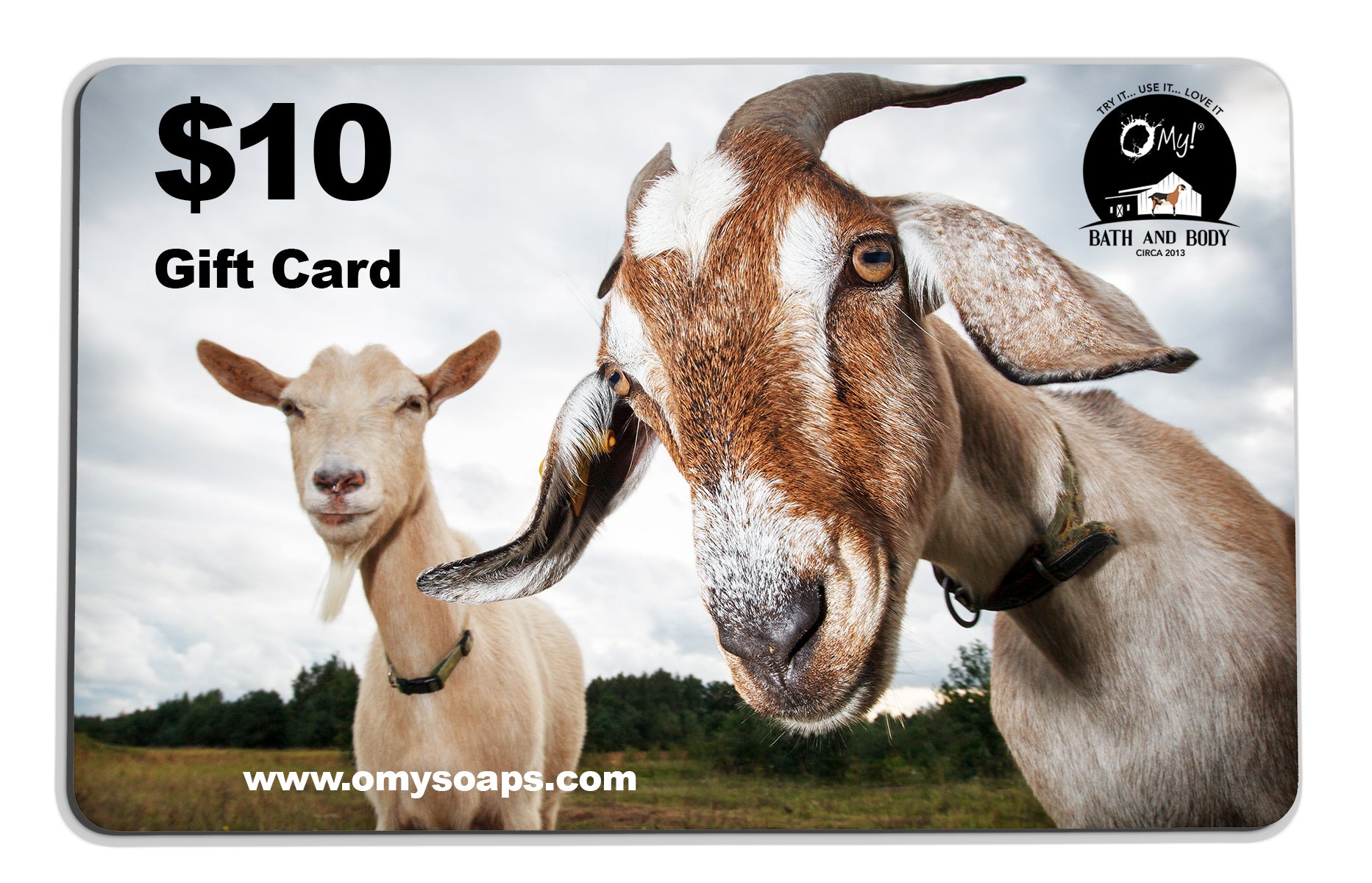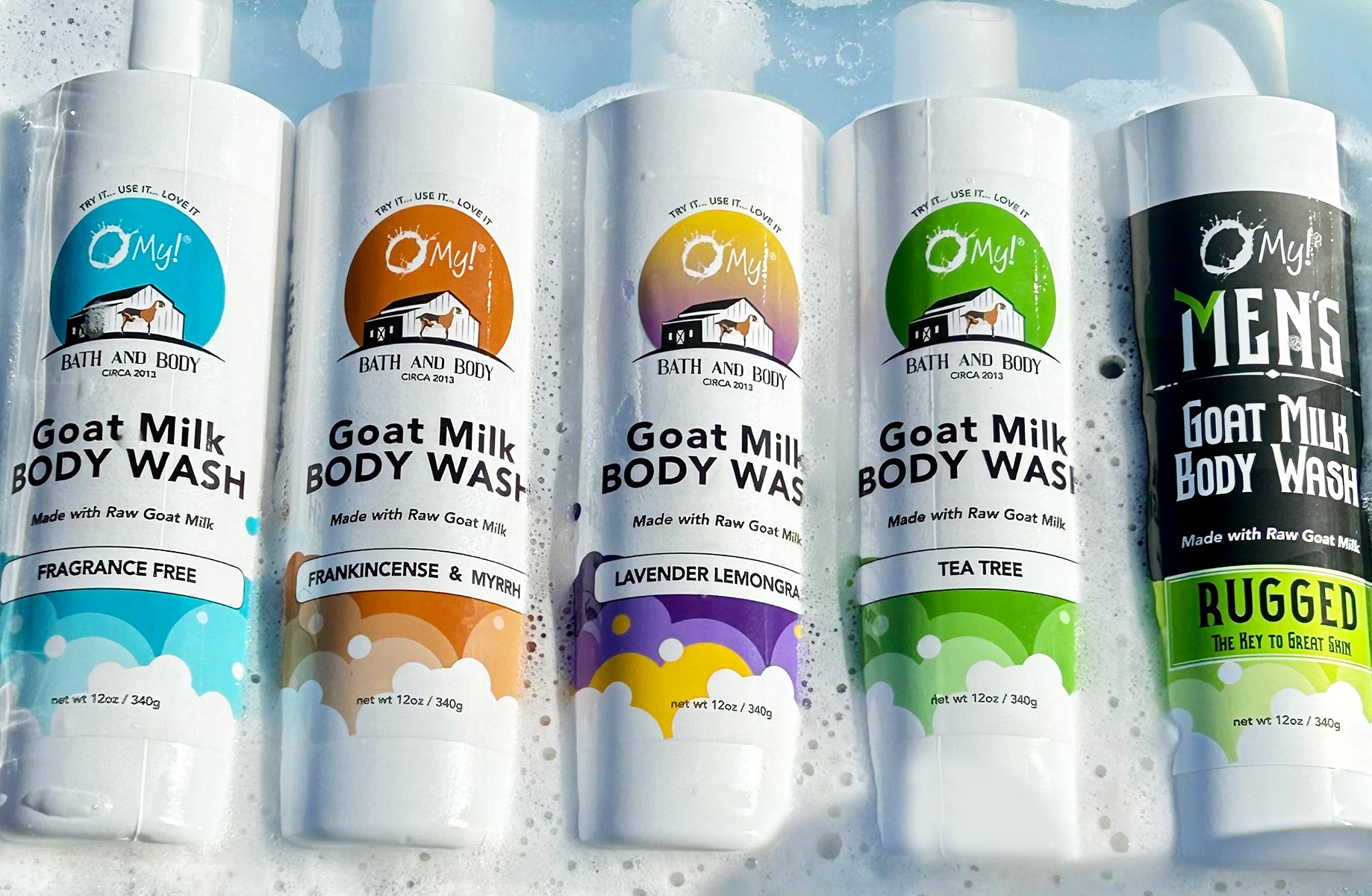O My! Ingredients

Why? Goat milk has unique properties not found in other milk. Goat milk is the only milk that contains capric capryllic triglyceride. Goat milk contains over 50 nutrients, minerals, acids and enzymes that help nourish and revitalize dehydrated skin. Modern science has discovered that goat milk soap has a pH level similar to healthy human skin and hair. Skin will be less prone to liver spots, lines, and wrinkles with regular use. Regular use can relieve symptoms of skin conditions such as eczema, acne and psoriasis.
Goat milk contains lots of nutrients like fats, proteins and other hormones that naturally benefit the skin. The benefits of goat milk soap can be felt by people suffering from various skin conditions or those just wanting to maintain youthful, rejuvenated skin.
Be careful... don't get fooled! Raw goat milk is far superior over powdered goat milk skincare.
Other "goat milk" skincare companies will use either powdered goat milk or a melt and pour base in their soap formulations out of convenience or to expand the profit margin. These cheaper options are a diminished byproduct of goat milk, thus creating a lesser than standard product, often-times creating a product that isn't able to provide the full benefits the companies tout.

Coconut Oil
Coconut oil is an edible oil extracted from the kernel or meat of matured coconuts harvested from the coconut palm (Cocos nucifera). Throughout the tropical world, it has provided the primary source of fat in the diets of millions of people for generations. It has various applications in food, medicine, and industry. Because of its stability, it is slow to oxidize and, thus, resistant to rancidity, lasting up to two years owing to the high saturated fat content. Many health organizations advise against the consumption of high amounts of coconut oil due to its high levels of saturated fat.Coconut oil can be used as a skin moisturizer, helping with dry skin and reduces protein loss when used in hair. Before the advent of electrical lighting, coconut oil was the primary oil used for illumination in India and was exported as cochin oil. Coconut oil is an important base ingredient for the manufacture of soap. Soap made with coconut oil tends to be hard, although it retains more water than those made with other oils and therefore increases manufacturer yields. It is more soluble in hard water and salt water than other soaps allowing it to lather more easily. A basic coconut oil soap is clear when melted and a bright white when hardened. Source: http://en.wikipedia.org/wiki/Coconut_oil
Olive Oil
Olive oil is a fat obtained from the olive (the fruit of Olea europaea; family Oleaceae), a traditional tree crop of the Mediterranean Basin. The oil is produced by grinding whole olives and extracting the oil by mechanical or chemical means.It is commonly used in cooking, cosmetics, pharmaceuticals, and soaps and as a fuel for traditional oil lamps. Olive oil is used throughout the world, but especially in the Mediterranean countries and, in particular, in Greece, which has the highest consumption per person. Olive oil has a long history of being used as a home remedy for skincare. Egyptians used it alongside beeswax as a cleanser, moisturizer, and antibacterial agent since pharaonic times. In ancient Greece, the substance was used during massage to prevent sports injuries, relieve muscle fatigue, and eliminate lactic acid buildup. In 2000, Japan was the top importer of olive oil in Asia (13,000 tons annually) because consumers there believe both the ingestion and topical application of olive oil to be good for skin and health. Source: http://en.wikipedia.org/wiki/Olive_oil
Castor Oil
Castor oil is a vegetable oil obtained from the castor bean (technically castor seed) that has an unusual structure and many uses. It is obtained by pressing the seeds of the castor plant, Ricinus communis (Euphorbiaceae). Sometimes called castor bean oil, this plant is not a member of the bean family.Castor oil is a colorless to very pale yellow liquid with mild or no odor or taste. Its boiling point is 313 °C (595 °F) and its density is 961 kg/m3. It is a triglyceride in which approximately 90 percent of fatty acid chains are ricinoleate. Oleate and linoleates are the other signifcant components. Its uses include skin disorders, burns, sunburns, cuts, and abrasions.Source: http://en.wikipedia.org/wiki/Castor_oil
Shea Butter
Shea butter is a slightly yellowish or ivory-colored fat extracted from the nut of the African shea tree (Vitellaria paradoxa). Shea butter is a triglyceride (fat) derived mainly from stearic acid and oleic acid. It is widely used in cosmetics as a moisturizer, salve or lotion. Shea butter is edible and is used in food preparation in Africa and also as a prophylactic. Occasionally the chocolate industry uses shea butter mixed with other oils as a substitute for cocoa butter,
although the taste is noticeably different.
The English word "shea" comes from s’í, the tree's name in the Bamana language of Mali. The French name karité comes from ghariti, its equivalent in the Wolof language of Senegal.[ In some parts of West Africa, Shea Butter is referred to as Ori.
Shea butter is mainly used in the cosmetics industry for skin and hair related products (lip gloss, skin moisturizer creams and emulsions, and hair conditioners for dry and brittle hair). It is also used by soap makers, typically in small amounts (5-7% of the oils in the recipe), because of its property of leaving a small amount of oil in the soap.
Source: http://en.wikipedia.org/wiki/Shea_butter
Cocoa Butter
Cocoa butter, also called theobroma oil, is a pale-yellow, edible vegetable fat extracted from the cocoa bean. It is used to make chocolate, as well as some ointments, toiletries, and pharmaceuticals. Cocoa butter has a cocoa avor and aroma.
Cocoa butter is one of the most stable fats known, a quality that coupled with natural antioxidants that prevent rancidity gives it a storage life of two to !ve years. The velvety texture, pleasant fragrance and emollient properties of cocoa butter have made it a popular ingredient in products for the skin, such as cosmetics, soaps and lotions.
The moisturizing abilities of cocoa butter are frequently recommended for treatment of chapped or burned skin and lips, and as a daily moisturizer to prevent dry, itchy skin. Cocoa butter's moisturizing properties are also said to be effective for treating mouth sores.
Source: http://en.wikipedia.org/wiki/Cocoa_butter
Phthalate Free Fragrances and/or Essential Oils
An essential oil is a concentrated hydrophobic liquid containing volatile aroma compounds from plants. Essential oils are also known as volatile oils, ethereal oils, or aetherolea, or simply as the "oil of" the plant from which they were extracted, such as oil of clove. An oil is "essential" in the sense that it carries a distinctive scent, or essence, of the plant. Essential oils do not form a distinctive category for any medical, pharmacological, or culinary purpose.
Source: http://en.wikipedia.org/wiki/Essential_oil
Kaolin Clay
Kaolin clay is considered to be one of the gentlest facial clays. It has kaolinite, a mineral that consists of layered silicate. While the mineral is found all over the world, it has been mined at the Kao-ling mountain (China) since ages.
Kaolin clay is suitable for almost all types of skin, especially sensitive skin. It mostly comes in white colour, but can also be pink, green or brown. Experts suggest that whiter the colour of Kaolin clay, the better its quality is.
7 known benefits of Kaolin Clay are as follows: absorbs extra oil, natural cleanser, exfoliator, soothes skin, evens out skin tone, natural shampoo, teeth whitener.
Source: https://skinkraft.com/blogs/articles/kaolin-clay-for-skin



























